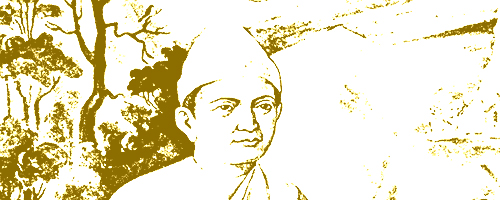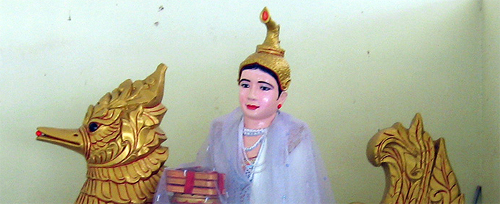
Bo Bo Aung, a weizza dressed as a layman.
A few months ago, I wrote a little about weizzas, supposed supernaturals in Burmese Buddhist belief.
Today, while searching on the Periodic Archives Online website, I discovered a scholarly journal article about weizzas, very much unknown to non-Burmese people. For much of the information I will provide, I consulted:
Ferguson, John P., and E. M. Mendelson. “Masters of the Buddhist Occult: The Burmese Weikzas.” Contributons to Asian Studies (Vol 16).
The word weizza (ဝိဇ္ဇာ), from Pali vijja means “knowledge” or “wisdom” and is commonly used to refer to Bachelors of Arts degrees. However, weizza is also the name of Burmese human beings who have gained supernatural powers (from flying to curing), usually transmitted from masters. This ‘cult’ within Burmese Buddhism developed prior the colonial era in response to the dramatic cultural and religious changes Burmese society had undergone, as the Burmese monarchy, the traditional epitome of Buddhist religion and Burmese culture, was ended.
The predecessors of weizzas in Burmese religion are zawgyi (ဇော်ဂျီ), wizards who are typically found in Burmese literature and yawgi (ယောဂီ), Buddhist yogis, who lead ascetic lives and wear brown robes, following the eight to 10 precepts of Buddhism (most laymen follow 5).
What’s interesting is how weizzas, who now seem so entrenched in popular Buddhist belief in Burma, came about during the Konbaung dynasty (the 1700s to 1800s), the last dynasty to rule Burma before colonial rule. Bo Bo Aung, a preeminent Burmese weizza, is believed by followers to have been a Buddhist monk in Sagaing (a major sangha center in central Burma) before discovering parabaik manuscripts that led him to form a cult of believers, as well as monks and hermits, who all wanted a shortcut to Nirvana through meditation and other mystical practices (Buddhists, even monks, cannot generally cease reincarnation and go to Nirvana). Belief in weizzas seems to have been “[a yearning] for the restitution of the old ways” (5).
To be a weizza means to be Buddhist. Many ‘recognized’ weizzas today come from before the Konbaung dynasty, such as monks like Shin Arahan and alchemists like Ayezagawna). Many monks from the Pagan dynasty are also considered weizzas, an interesting notion, because during the Pagan Dynasty, Ari Buddhism, a mystical form of Tantric form of Buddhism with corrupt monks (အရည်ကြီး) co-existed with Theravada Buddhism, established as the state religion by Anawrahta.

Photo of a Thuyathadi statue at the Kyaukdawgyi Paya in Insein Township, Yangon
Weizzas are also intricately tied to the Hindu-influenced beliefs that Burmese Buddhism carries today. Many Burmese today worship gods like Vishnu and Sarasvati as ‘nats’ (spirits) who protect Buddhism (nats also exist in trees, mountains, but can also be historical people who died violent and untimely deaths). The elaborate ties Burmese Buddhism has to pre-Buddhist practices like nat worship, other forms of Buddhism and Hinduism provide a pantheon of choices from which people can choose to worship and practice, even if it all falls under the label of ‘Theravada Buddhism’. Weizzas have sought legitimacy through Buddhist nats like Thuyathadi (borrowed from Hindu Sarasvati) and considered the protector of Buddhist scriptures.
Today, weizza following still exists in Burma, especially among the poorer classes of Burmese society, who seek emancipation from their present suffering and trouble. This is similar to the Roman adoption of Christianity as the state religion, where the lower classes were more likely to seek ‘salvation’ and were the first to adopt Christianity, while the ruling classes were resistant). The socialist government during the Ne Win era suppressed weizza folllowing, forbidding publication of weizza materials and selling weizza prints sometimes found in household altars. Despite its suppression, interest in weizzas remains high, and many Burmese readily accept weizzas, an offsprout of changing times in the period leading to colonial rule, as part of Buddhist beliefs.
Although I doubt the existence of weizzas, who in many instances claim to have lived centuries, delayed reincarnation and have other beliefs that seem incompatible with Buddhism, many others hold opposing views. It’s interesting how weizzas, who originally sought to return followers to traditional ‘old’ ways, incorporate Buddhist and Hindu mythology and some fantasy, have become a panacea for many Burmese Buddhists struggling in life.
If anyone has more information, corrections, etc, please leave comments because I’m very interested in the concept of weizzas, who are unique to Burmese Buddhism.
Note: For Burmese text, I have used a Unicode-compatible font (I suggest Padauk). For reasons on why Zawgyi is outdated, learn more here.
Hi
How do you want me to help with Burmese wikipedia? I checked the page, but I think I don’t have the correct font installed. I’m using Zawgyi-One, which is used on most burmese pages on the web.
Drop me a mail please.
My uncle is a great believer in Weizza. I grew up listening to many wonderful stories and his own personal encounters with them. I wish I remember most of his stories and the weizza’s names in details, but with his great knack of storytelling, we children were mesmerized by the stories, and always looked forward to visiting his house. Your wonderful post takes me back to my childhood.
I am french… i’m trying to study about weizza for personal but also for school project… i really would like to hear about those stories… my wife is burmese..if u can help me… thanks
Nice article. I shared it to my friends in Google Reader. I’ve subscribed yours.
I’ve witnessed some of them recently.To my amazement, they can do wonders–grasping a loadstone in the air and pulling out another through the lenseof the camera and appearing diamonds around the Shaman(weikza)!
Thank you for sharing your interest in weizza path. I have seen photos of ye thays (brown robes, conical leather hats, often hermits) in Myanmar today…do you have any information about their current spiritual practice? …and how and if they can be approached?